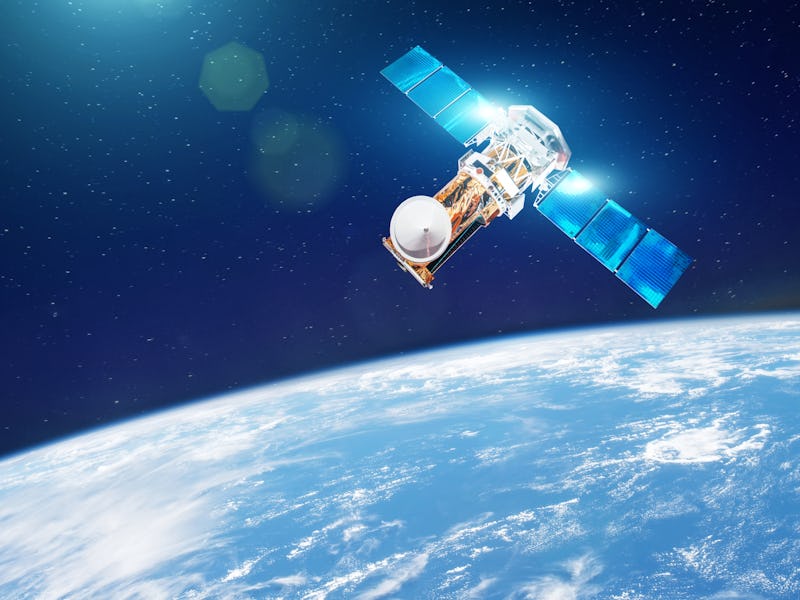A space-age breakthrough could make satellite coverage cheaper than ever
Researchers have developed a means to blanket the Earth with very little.

Forget SpaceX Starlink: it turns out it’s possible to achieve near-complete Earth coverage with just four satellites.
While many constellations use tens of satellites to achieve full coverage, researchers at Cornell University may have discovered a means to achieve similar service with far fewer. By harnessing the sort of forces that normally degrade satellites, the team was able to create a design that could achieve 86 percent coverage over a 24-hour period and 95 percent coverage over a 48-hour period. The research, sponsored by the National Science Foundation and involving collaborating from a number of institutions, was published Friday in the journal Nature Communications.
The research comes as the trend in satellites moves toward more, rather than less. There are currently around 5,000 satellites in orbit total. SpaceX has applied for permission to launch up to 42,000 as part of its Starlink internet service, designed to provide high speed and low latency service around the world. Other potential entrants in this space include Amazon’s Project Kuiper, which would cover 3,236 craft. Astronomers have voiced their concerns, however, that the initial batches of Starlink satellites are already disrupting work.
A SpaceX Starlink satellite unfolding.
This new project is unlikely to replace these mega-constellations. One of the goals of Starlink, for instance, is to operate at a very low altitude of 550 kilometers to reduce latency. This new project proposes a very high altitude to better leverage forces, resulting in far lower costs than traditional constellations. That could, however, open up full-Earth coverage to more teams than ever.
The team’s work follows on from that of researcher John E. Draim, who suggested in the 1980s that four satellites could prove sufficient for coverage. The costs and amount of fuel put a damper on the idea.
This new project looked at how it could use existing forces to achieve coverage. These new satellites would float at high elevation, requiring little propellant and avoiding other satellites. The researchers ran their designs through a simulation at Blue Waters supercomputer at University of Illinois, Urbana-Champaign, which simulated 300 to 400 years of operation in just one month. It found that satellite lifespans could increase from five years to 15 years, reach high levels of coverage with just four craft, and lead to gaps in coverage for low-priority areas lasting just 80 minutes.
“There might be missions where you absolutely need coverage of everywhere on Earth, and in those cases, you would just have to use more satellites or networked sensors or hybrid platforms,” Patrick Reed, engineering professor at Cornell University, said in a statement.
Full Earth coverage: could it be possible?
A company or country with limited resources could use the proposal to run its own constellation with very little investment. Thanks to the proliferation of commercial launching firms like SpaceX and Blue Origin, there’s an emerging space race of firms keen to launch satellites for third-party contractors — making space more accessible than ever to these cash-strapped entities.
“Even one satellite can cost hundreds of millions or billions of dollars, depending on what sensors are on it and what its purpose is. So having a new platform that you can use across the existing and emerging missions is pretty neat,” Reed said. “There’s a lot of potential for remote sensing, telecommunication, navigation, high-bandwidth sensing and feedback around the space, and that’s evolving very, very quickly. There’s likely all sorts of applications that might benefit from a long-lived, self-adapting satellite constellation with near global coverage.”
Sure, Starlink and the like may be focused on filling the skies with thousands of craft, but perhaps the coolest innovations could come from small teams launching a few satellites while still reaching high levels of coverage.
>Abstract:
Satellite services are fundamental to the global economy, and their design reflects a tradeoff between coverage and cost. Here, we report the discovery of two alternative 4-satellite constellations with 24- and 48-hour periods, both of which attain nearly continuous global coverage. The 4-satellite constellations harness energy from nonlinear orbital perturbation forces (e.g., Earth’s geopotential, gravitational effects of the sun and moon, and solar radiation pressure) to reduce their propellant and maintenance costs. Our findings demonstrate that small sacrifices in global coverage at user-specified longitudes allow operationally viable constellations with significantly reduced mass-to-orbit costs and increased design life. The 24-hour period constellation reduces the overall required vehicle mass budget for propellant by approximately 60% compared to a geostationary Earth orbit constellation with similar coverage over typical satellite lifetimes. Mass savings of this magnitude permit the use of less expensive launch vehicles, installation of additional instruments, and substantially improved mission life.